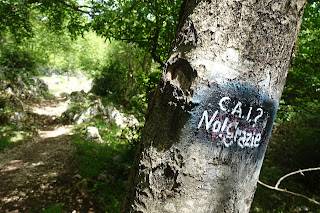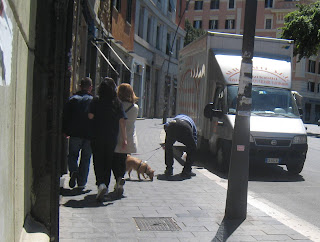 |
The best of trail markers - at the top. Here, Monte Gennaro - "Rome's mountain," complete with cross, Italian flag, and
clear markers - once you are up there - of the various ways down. |
Who would have thought trail markers would have turned into a debate about Italian war history, geology and hiking myth?
 |
Here's a mysterious one - again, on Monte Gennaro - the
traditional trail marker has been replaced with... well, you
see what. |
We shouldn't have been surprised. Signed trails in central Italy can be more entertainment than guides much of the time. Since we've hiked almost every peak within 50 miles of Rome - and there are probably 100 - we like to think we're experts.
Yet, getting lost is one of our fortes as well. It's partly us, it's partly the trail maps slapped over WWII maps and not updated, it's partly the vandalism of trail markers, and it's partly the inadequacies of central Italy's trail system.
Central Italians tend to prefer the sea to the mountains. And, after all, it's not the Alps. Still, as I said, it can be entertaining. So here are some of the markers we learned from, puzzled over, and laughed at so far this Spring.
First, we learned some history. On our hike to
Monti Gemma and Malaina, that Bill wrote about recently, one of our fellow hikers told the story he was told by a guide as they were hiking around Monte Cassino (where the Allies in February 1944 bombed the abbey to smithereens trying to drive out the Germans). That story, as our fellow hiker reported to our group, was that some thought the markers were to commemorate the Poles who actually took Monte Cassino, after multiple attempts by multiple armies, 3 months later, on May 18, 1944. The Polish flag is red and white.
 |
| Polish flag |
 |
Austria-Hungary flag; the Austria-
Germany flag of 1918-1919 is pure
red and white. |
No, he was told by this guide, the generally consistent red and white trail markers derived from the Austro-Hungarians in World War I marking their retreat line with the colors of their flag. I don't think he meant to say they were around Monte Cassino, which is south of Rome, but just that this is how the system started.
 |
A confused and confusing marker -
red and white? yellow and red? blue? |
"No, no," said our guide, Domenico, that's a myth. As Domenico told his version of the story, the marking system in central Italy--basically in all the Apennines which run lengthwise through the country--was red and yellow. They did not use white because the rocks of the Apennines are limestone, which is white, and so white is not a good color to use.
 |
| CAI's red and white - no mistaking it here. |
But, after World War II, the Europeans decided to use one coloring system. The dominant Italian group maintaining the trail system is CAI (rhymes with "eye"), Club Alpino Italiano ("Italian Alpine Club"). The red and white was used in the Alps, and because the northern Italians dominate the hiking scene - their mountains are higher (though the Gran Sasso a few hours from Rome is 10,000 feet) - they won out. The central Italians clearly think to this day that white is just plain wrong. BTW, I googled quite a bit, and it looks like Domenico's story is likely the correct one.
 |
Look behind the cows and calves and you'll see blue markers. So blue is still in use.
On the high plain on Monte Gennaro. Can't resist the animal shots. |
 |
| First we saw just blacked-over markers. Was the trail out of commission? |
And then we discovered this Spring on our perhaps 5th hike up "Rome's mountain"--Monte Gennaro, the tallest that looms outside of the city--that the trail markers had been "cancellato," or blacked out, probably with spray paint.
 |
First the CAI sign is spray painted over black, then
someone has written: "CAI? No! thanks" |
We went back and forth on the trail a few times to see if there was some reason the trail might have been re-routed, but, finding nothing, kept going. We thought perhaps someone wanted to turn the trails more back to nature, as has happened to some extent in the Adirondacks in New York. By eliminating trail markers, fewer people take the trails and one route does not become eroded.
But then we saw the reason here. Someone is having a feud with the hiking section maintaining the trails: the Tivoli section of CAI (Tivoli is the closest 'large' town). Soon we saw that CAI had come along and painted their red and white markers over the black paint, and then someone else had come along and written on the CAI markers various blasphemes at CAI (see the photos). We haven't been able to figure out the source of the feud. But there it is.
 |
This one says "CAI section Tivoli - Mafiosi!" - more
blasphemous tree signs (who would've thought that was
even a concept) are at the end of the post. |
 |
This says "Path of the Partisans" and points a different
direction from the trail. What's the politics here?
Still on Monte Gennaro. |
On a recent hike on some nice mountains behind Tivoli 20 miles outside of Rome, we took an incredibly steep trail down (we had taken it up a few years ago). It now has been marked with extensive stonework, by a mountain biking group. How anyone can bike this trail - or run it (we saw a trail runner too) is totally beyond our comprehension. One can barely keep upright hiking it.
 |
| Dianne with a "uomini" |
But, this group has moved a lot of stones to put in large markers of stacked stones, what we call 'cairns' and are called "uomini" or "little men" in Italian - these are the largest 'little men' we've seen. These, by the way, are useful where the white doesn't show up against the limestone. The group also put in some stone circles and other markers that some might argue are not consistent with the wild. But since one is hiking amidst grazing farm animals, and ex-farm buildings and stone farm walls (as in the cow photo above), this is a different kind of 'wild.' We haven't yet come down on one side of the debate.
 |
| Your guess is as good as ours. |
A couple other words to the wise trekker. Often the signs have been vandalized. One can have very clear signs, and then none at all. If you see a map on a signboard (most of those have been demolished as well - by vandals, not because of feuds), take a picture with your camera or phone. We encountered a young German hiking behind Tivoli and he managed using this technique plus a GPS app. Of course, even the pictures can be wrong and misleading. But it's a start. And, the two of us debate the use of GPS. It seems like cheating. One of us (that's me!) likes to haul out the iPhone now and then to see if we're anywhere near where we should be. The other one (that's Bill) enjoys the pleasure following the anxiety of losing the trail.
 |
The young German knew enough to fill up his water bottle
at the Tivoli train station (nice 'statue' to symbols of
Tivoli, including the aqueducts). |
 |
Classic CAI trail markers - this is trail #215 in Rome - on Monte Mario.
These are great, until they disappear. BTW, the numbers are hours and
minutes, not kilometers or miles (yep, we made that mistake once -
believe me, 2 hours is a lot longer than 2 kilometers!). And who
knows what sign was once in those pieces of metal now framing nothing. |
These pleasures and anxieties can be found in the parks and hills within Rome as well.
Monte Mario, which is the most significant 'mountain' IN Rome, is a great hiking spot, with lots of trails, totally confusing markings, and everything from waist-high weeds to great views (of St. Peter's, of the Tiber, of all of Rome). We've written about it before, and we suggested a hike up it in our first guidebook, "Rome The Second Time." Since we published that itinerary, the 'mountain' or park has had trails added, and markers added and deleted. If you don't mind being a little lost at times, go for it.
 |
We found this map on a signboard on Monte Mario. It has its
defects - no numbered trails. Where we came in and out
isn't even on the map, but it gave us some sense of where
we were. |
The last time we were on Monte Mario we encountered 4 English-speaking 'pilgrims,' who were walking the via Francigena, St. Frances's walk. They had 100 miles under their hiking belts, from Orvieto north of Rome, and were within a couple hours of their destination - St. Peter's. They were doing it all with some "turn left here, turn right" typed directions. Impressive! We, of course, told them where to find the best bar with a view in the next 30 minutes of their walk. The pilgrims seemed happy to get that information.
We've said it before, but it bears repeating, "buon trekking." Dianne
 |
| "CAI section Tivoli - Shits!" |
 |
| "CAI section Tivoli - Bastards!" |









